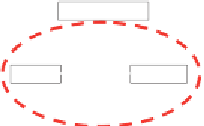Environmental Engineering Reference
In-Depth Information
behavior of the i ber once the micropores were blocked with the resin.
Although water molecules are absorbed into the cell wall, the i ber can only
swell by an additional amount of water which is dependent upon the bulk-
ing of the cell wall due to the volume occupied by the impregnation agent.
h us, it is concluded that the moisture absorption of i bers is reduced due to
the physical blocking of cell wall OH groups, which also contributes to the
improvement in the dimensional stability of the i ber and its composites. It
was also observed that the rate of absorption of the i ber impregnated with
PF was sligthly lower than that of UP, as seen in the regression trends. It was
expected that a higher WPG of PF imparted a slightly lower WA than UP.
h e resin molecules were forced into the cell wall of the i ber as the pres-
sure increased, resulting in deep penetration into the i ber, and extensive
penetration was believed to occur due to the smaller resin molecules of PF.
h e WA was found to reduce as pressure increased, of which the lowest WA
was observed for the i bers impregnated at pressures of 500 mmHg (22.52%)
for PF and 600 mmHg (23.97%) for UP, while no signii cant increase was
observed at the higher pressure of 500 mmHg (23.31%).
h e phenomena can well be understood by comparing the scanning
electron microscope (SEM) cross-section views of fractured surfaces of
the control, PF-, and UP-impregnated i bers (at a pressure of 500 mmHg).
Figure 5.6a shows that the i ber has an open lumen, which is believed to
be a mechanism for water to i ll before dif using into the cell wall. During
impregnation, the lumen and the cell wall were impregnated with resin,
which immediately prevented the penetration of water. h e resin was
deposited extensively into the i ber cell wall and it enclosed the hydrophilic
property of the i ber, which caused the i ber to become highly water resis-
tant. h is is shown in Figure 5.6b where the lumen of the i ber was partially
impregnated with PF resin and is similar to Figure 5.6c, which shows the
lumen partially i lled with UP resin.
Unilled cell lumen
Partially illed
Fully illed
Partially illed
Fully illed
Cell wall
Cell lumen
(
a
)
(
b
)
(
c
)
Figure 5.6
(a) Surface of control sample; (b) Surface of PF-impregnated i ber; (c) Surface
of UP-impregnated i ber.






















Search WWH ::

Custom Search